
1introjunos
.pdf
Introduction to JUNOS Software
Separate Control and Forwarding Planes (contd.)
The PFE, shown below the dashed line on the slide on the previous page, usually runs on separate hardware and is responsible for forwarding transit traffic through the device. In many platforms running JUNOS Software, the PFE uses application-specific integrated circuits (ASICs) for increased performance. Because this architecture separates control operations—such as protocol updates and system management— from forwarding operations, platforms running JUNOS Software can deliver superior performance and highly reliable deterministic operation.
The PFE receives the forwarding table (FT) from the RE by means of an internal link. FT updates are a high priority for the JUNOS Software kernel and are performed incrementally.
|
Because the RE provides the intelligence side of the equation, the PFE can simply |
|
|
|
Reproduction |
|
perform as it is instructed—that is, it forwards frames, packets, or both with a high |
|
|
degree of stability and deterministic performance. This architectural design also |
|
|
makes possible the incorporation of high-availability features like graceful Routing |
|
|
Engine switchover (GRES), nonstop active rou ing (NSR), and in-service software |
|
|
upgrades (ISSUs). |
|
Not |
for |
|
|
|
|
JUNOS Software Fundamentals • Chapter 2–7
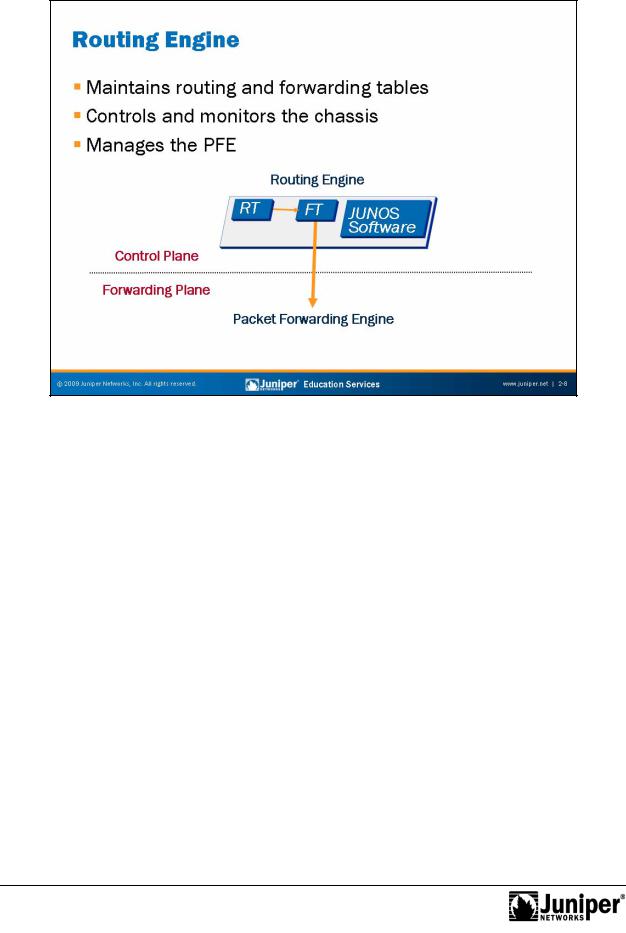
Introduction to JUNOS Software
Maintains Routing Engine Int lligence
The RE handles all protocol processes in addition to other software processes that |
|
control the device’s interfaces, the chassis components, system management, and |
|
user access to the device. These software processes run top of the JUNOS kernel, |
|
which interacts with theReproductionPFE. The software directs all protocol traffic from the network |
|
to the RE |
the required processing. |
C n r ls and Monitors Chassis |
|
Not |
for |
The RE provides the CLI in addition to the J-Web GUI. These user interfaces run on top of the JUNOS kernel and provide user access and control of the device. We discuss user interfaces in a subsequent chapter in this course.
Manages Packet Forwarding Engine
The RE controls the PFE by providing accurate, up-to-date Layer 2 and Layer 3 forwarding tables and by downloading microcode and managing software processes that reside in the PFE’s microcode. The RE receives hardware and environmental status messages from the PFE and acts upon them as appropriate.
Chapter 2–8 • JUNOS Software Fundamentals
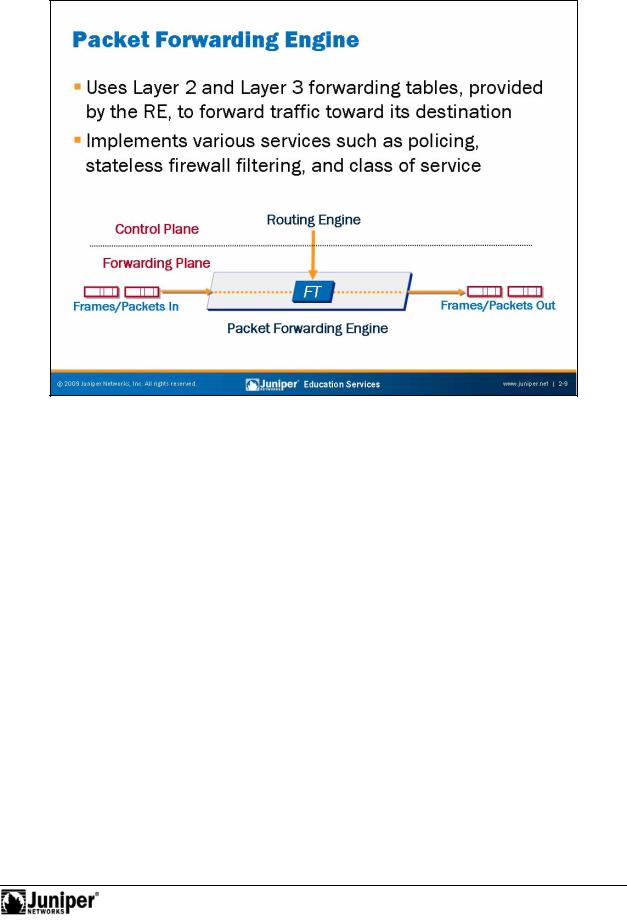
Introduction to JUNOS Software
Forwards Traffic
The PFE is the central processing component of the forwarding plane. The PFE systematically forwards traffic based its local copy of the forwarding table. The
PFE’s |
wa ding table is a synchronized copy of the information created on and |
pr vided by theReproductionRE. Storing and using a local copy of the forwarding table allows the |
|
PFE to |
rward traffic more efficiently and eliminates the need to consult the RE each |
ime a packet needs to be processed. Using this local copy of the forwarding table also |
|
for
Notallows platforms running JUNOS Software to continue forwarding traffic during control plane instabilities.
Implements Services
In addition to forwarding traffic, the PFE also implements a number of advanced services. Some examples of advanced services implemented through the PFE include policers that provide rate limiting, stateless firewall filters, and class of service (CoS). Other services are available through special interface cards that you can add to the PFE complex. We cover interfaces in a subsequent chapter.
JUNOS Software Fundamentals • Chapter 2–9
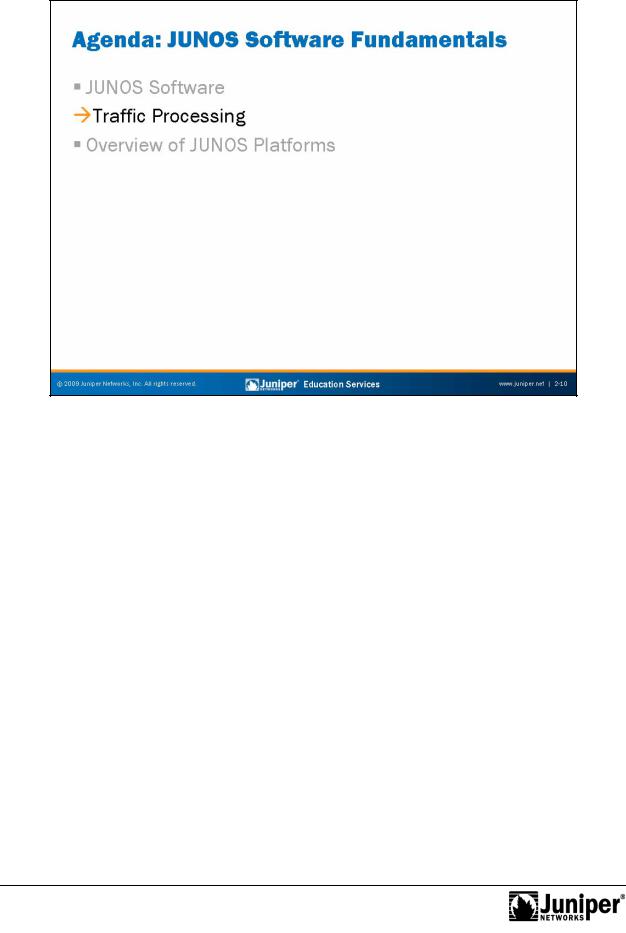
Introduction to JUNOS Software
Traffic Processing |
|
|
The slide highlights the topic we discuss next. |
||
|
for |
Reproduction |
Not |
|
|
|
|
|
Chapter 2–10 • JUNOS Software Fundamentals
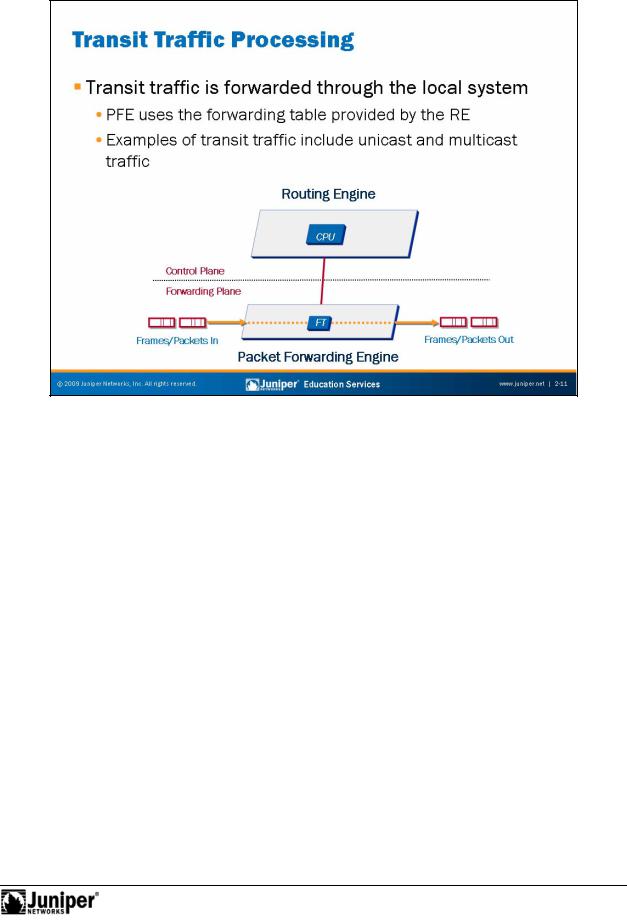
Introduction to JUNOS Software
Transit traffic consists of all traffic that enters an ingress network port, is compared foragainst the warding table entries, and is finally forwarded out an egress network port towa d its destination.
Transit TrafficReproduction
A rwa ding table entry for a destination must exist, for a device running JUNOS
S tware to successfully forward transit traffic to that destination. Transit traffic only passes through the forwarding plane and is never sent to or processed by the control
Notplane. By processing transit traffic through the forwarding plane, platforms running JUNOS Software can achieve predictably high performance rates.
Transit traffic can be both unicast and multicast traffic. Unicast transit traffic enters one ingress port and is transmitted out exactly one egress port toward its destination. Although multicast transit traffic also enters the transit device through a single ingress port, it can be replicated and sent out multiple egress ports depending on the number of multicast receivers and the network environment.
JUNOS Software Fundamentals • Chapter 2–11

Introduction to JUNOS Software
Exception Traffic: Part 1
Unlike transit traffic, exception traffic does not pass through the local device but rather requires some form of special handling. Examples of exception traffic include
the following: |
Reproduction |
|
• |
|
|
Packets addressed to the chassis, such as routing protocol updates, |
||
|
Telnet sessions, pings, traceroutes, and replies to traffic sourced from |
|
|
the RE; |
|
• |
forIP packets with the IP options field (Options in the packet’s IP header are |
|
|
rarely seen, but the PFE was purposely designed not to handle IP options; |
|
|
packets with IP options must be sent to the RE for processing); and |
|
• |
Traffic that requires the generation of Internet Control Message Protocol |
|
Not |
(ICMP) messages. |
|
|
|
|
ICMP messages are sent to the packet’s source to report various error conditions and to respond to ping requests. Examples of ICMP errors include destination unreachable messages, which are sent when there is no entry in the forwarding table for the packet's destination address, or time-to-live (TTL) expired messages, which are sent when a packet’s TTL is decremented to zero. In most cases, the PFE process handles the generation of ICMP messages.
Chapter 2–12 • JUNOS Software Fundamentals
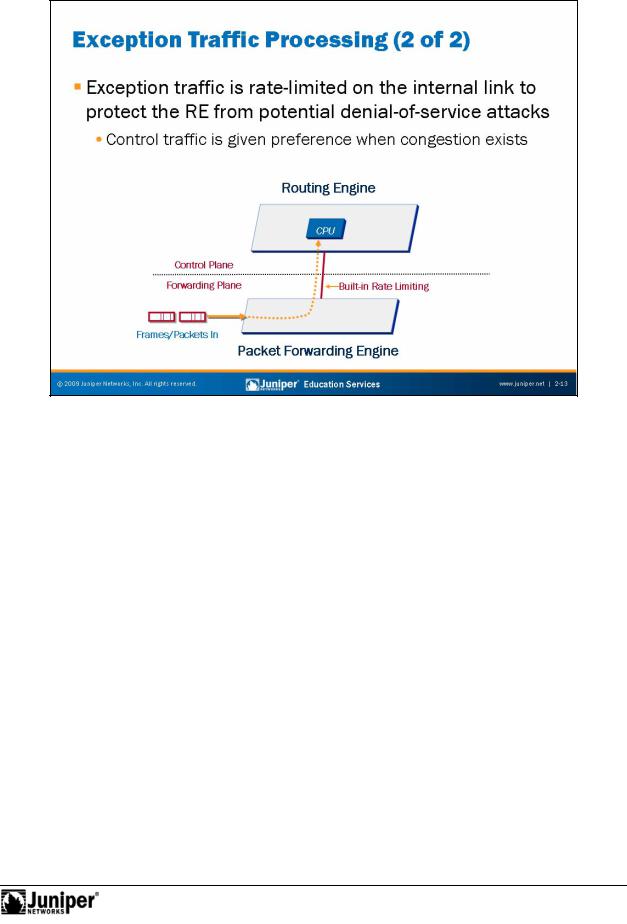
Not
Introduction to JUNOS Software
Exception Traffic:ReproductionPart 2
JUNOS Software sends all exception traffic destined for the RE over the internal link that connects the control and forwarding planes. JUNOS Software rate limits exception trafficfort ave sing the internal link to otect the RE from denial-of-service (DoS) attacks. Du ing times of congestion, the JUNOS Software gives preference to the local and c ntr l traffic destined for the RE. The built-in rate limiter is not configurable.
JUNOS Software Fundamentals • Chapter 2–13

Introduction to JUNOS Software
|
|
Reproduction |
Platforms Running JUNOS Software |
||
The slide highlights the topic we discuss next. |
||
Not |
for |
|
|
|
|
Chapter 2–14 • JUNOS Software Fundamentals
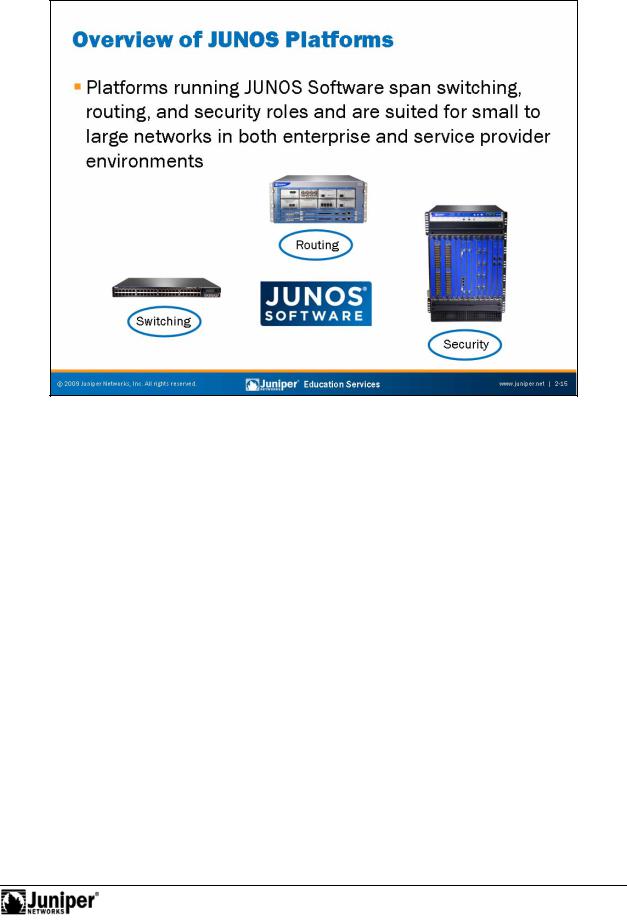
Introduction to JUNOS Software
Platforms running JUNOS Software come in many shapes and sizes and are targeted fora number of deployment scenarios. Th platforms running JUNOS Software span switching, outing, and security and are well suited for a variety of network
Platforms RunningReproductionJUNOS Software
envir nments. As the heart of all these platforms, the JUNOS Software provides a c nsistent end-to-end IP infrastructure in small enterprise environments and the
largest service provider networks alike. The subsequent slides introduce and provide Notsome details for each product family.
JUNOS Software Fundamentals • Chapter 2–15
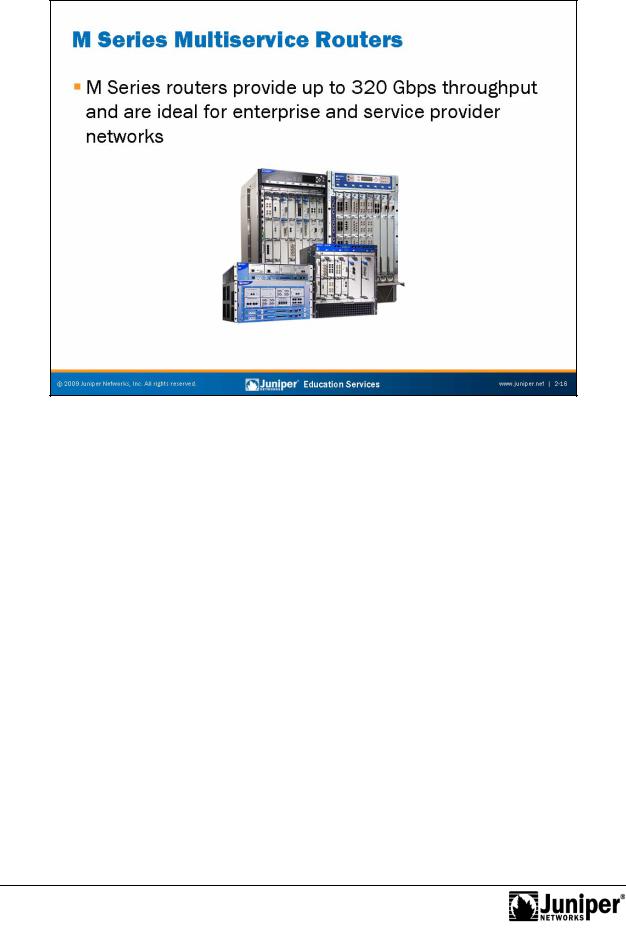
Introduction to JUNOS Software
M Series MultiserviceReproductionRout rs
The M Series multiservice routers provide up to 320 Gbps of aggregate half-duplex throughput. You can deploy the M Series family can be deployed in both high-end enterpriseforand se vice-provider environments. Large enterprises deploy M Series routers in a number f different roles, including Internet gateway router, WAN connectivity uter, campus core router, and regional backbone and data center
Notrou ers. In service-provider environments, the M Series router operates predominantly as a mul iservice edge router, but you can also deploy it in small and medium cores, and in peering, route reflector, multicast, mobile, and data-center applications.
F r additional, in-depth details on the M Series multiservice routers, go to http://www.juniper.net/products_and_services/m_series_routing_portfolio/ index.html.
Chapter 2–16 • JUNOS Software Fundamentals
